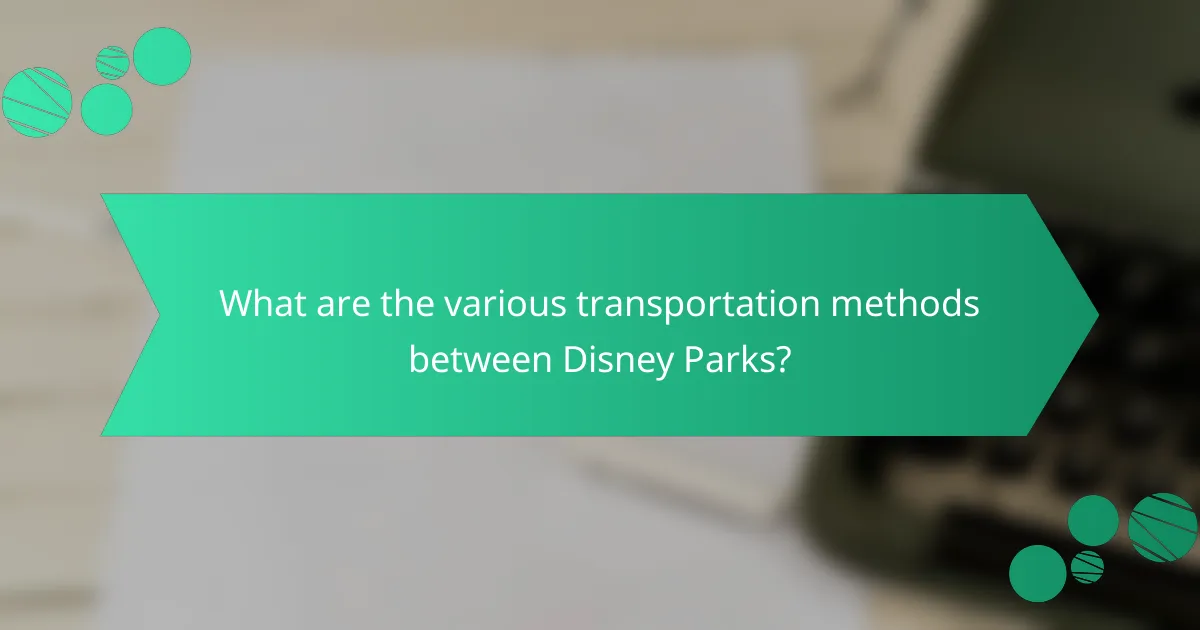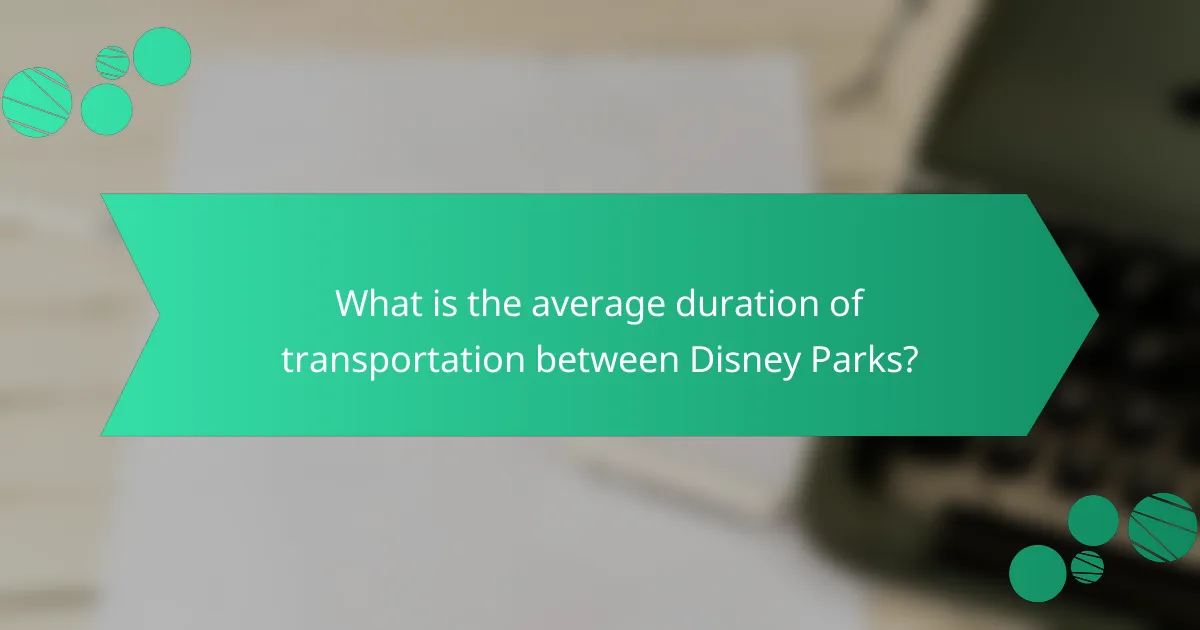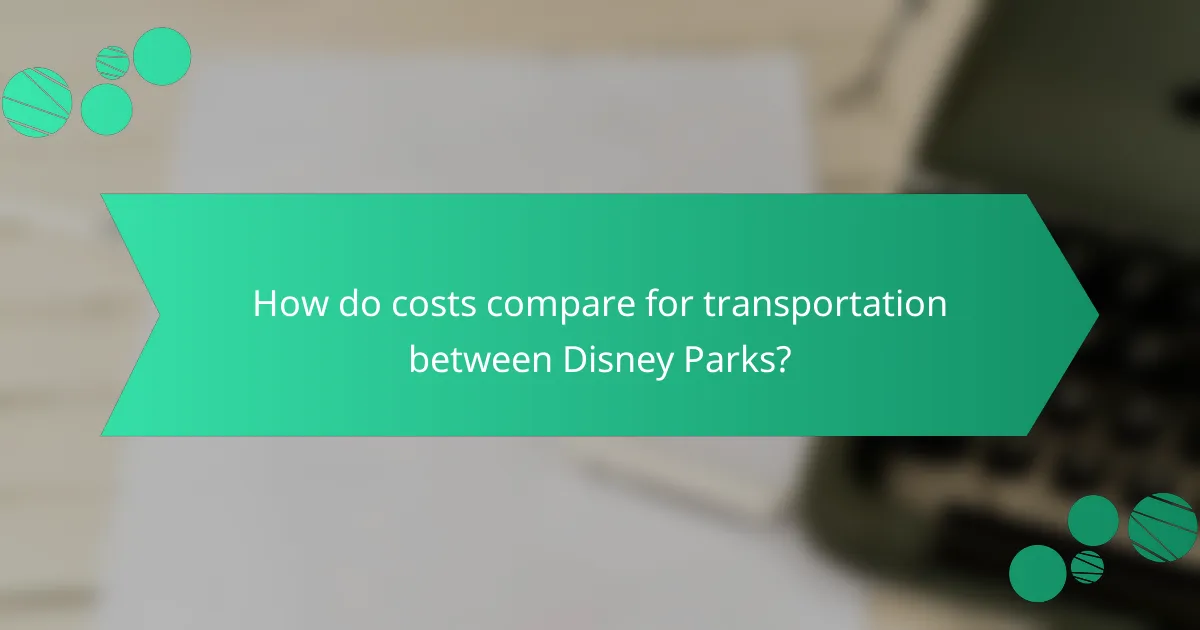
What are the various transportation methods between Disney Parks?
The various transportation methods between Disney Parks include buses, monorails, boats, and the Disney Skyliner. Buses provide direct service between parks and resorts, operating frequently throughout the day. Monorails connect select parks, offering a scenic and efficient ride. Boats operate on waterways between parks, providing a relaxing travel option. The Disney Skyliner is a gondola system that links certain parks and resorts, enhancing the overall experience. Each method is designed to accommodate guests efficiently, ensuring smooth transitions between locations.
How do different transportation options compare in terms of convenience?
Different transportation options vary significantly in convenience. Buses provide direct routes between parks but may have longer wait times. Monorails offer quick access but are limited to specific locations. Boats provide scenic routes but can be slower due to water traffic. Rideshare services offer door-to-door convenience but depend on availability and surge pricing. Walking paths are direct but can be tiring, especially for families. Each option’s convenience is influenced by factors like travel time, frequency, and ease of access.
What are the characteristics of buses as a transportation method?
Buses as a transportation method are characterized by their capacity, efficiency, and accessibility. They typically accommodate a large number of passengers, often ranging from 20 to 60 seats. Buses operate on fixed routes and schedules, providing predictable travel times. They are generally cost-effective, making them an affordable option for many travelers. Buses also offer accessibility features for individuals with disabilities. Additionally, they can navigate urban and suburban areas, connecting various destinations. Many public bus systems provide real-time tracking for convenience. Buses contribute to reduced traffic congestion and lower carbon emissions compared to individual car travel.
How does the monorail system operate between parks?
The monorail system operates by connecting multiple Disney parks through elevated tracks. It transports guests between key locations efficiently. The system features automated trains that run on a fixed schedule. Trains arrive at stations approximately every 10 to 15 minutes. Guests board the monorail at designated stations near the parks. The ride offers scenic views of the parks and resorts. The monorail is a popular choice due to its convenience and speed. It serves as both a mode of transportation and an attraction itself.
What role do boats play in park transportation?
Boats serve as a vital mode of transportation between Disney parks. They provide a scenic and leisurely alternative to buses and monorails. Boats connect various locations, enhancing accessibility for guests. They operate on specific routes, reducing travel time between parks. The average travel duration on boats ranges from 10 to 30 minutes, depending on the distance. Boats also accommodate a significant number of passengers, ensuring efficient transport during peak times. This method of transportation adds to the overall experience by offering picturesque views of the parks and surrounding areas.
How do rideshare services integrate with Disney transportation?
Rideshare services integrate with Disney transportation by providing convenient pickup and drop-off locations at Disney properties. These designated areas are often located near the entrance of parks and resorts. Guests can easily summon rideshare vehicles through apps like Uber or Lyft. This integration enhances accessibility for visitors without personal vehicles. Disney has established clear signage to guide guests to these pickup points. Additionally, rideshare services complement Disney’s transportation options, such as buses and monorails. This collaboration allows for seamless travel between various locations. Overall, rideshare services enhance the overall transportation experience at Disney.
What factors influence the choice of transportation method?
Factors influencing the choice of transportation method include cost, convenience, time, and environmental impact. Cost is a significant factor as travelers often compare expenses associated with different modes. Convenience relates to accessibility and ease of use for passengers. Time considerations involve the duration of travel and waiting periods. Environmental impact is increasingly important, with many opting for greener options. Research shows that 70% of travelers prioritize cost and convenience when selecting transportation.
How does park proximity affect transportation decisions?
Park proximity significantly influences transportation decisions. Closer parks generally lead to reduced travel time and costs. Visitors often prefer walking or biking to nearby parks. Shorter distances decrease reliance on cars or public transport. Research shows that proximity encourages more frequent visits. For example, parks within a mile radius see higher foot traffic. This pattern is evident in urban planning studies. Such studies confirm that accessibility shapes transportation choices.
What are the advantages of using Disney’s own transportation services?
Disney’s own transportation services offer several advantages. They provide complimentary transportation for resort guests. This service includes buses, boats, and monorails. It enhances convenience by connecting all parks and resorts. Guests can avoid parking fees and long walks. The transportation is designed for efficiency, with regular schedules. Additionally, it allows for a seamless transition between parks. Disney’s transportation is also themed, adding to the overall experience. This service supports a stress-free visit to the parks.
How do personal vehicles compare to Disney transportation options?
Personal vehicles offer flexibility and convenience compared to Disney transportation options. Guests can travel on their own schedule without waiting for buses or monorails. Parking is available at Disney parks, but it incurs a daily fee, typically around $25. Disney transportation includes buses, boats, and monorails, which are complimentary for resort guests. However, these options may involve longer wait times and limited operating hours. Personal vehicles allow direct access to off-site locations, while Disney transportation is restricted to park properties. Overall, personal vehicles provide more control over travel time and destinations, while Disney transportation offers cost-free travel within the resort.

What is the average duration of transportation between Disney Parks?
The average duration of transportation between Disney Parks is approximately 30 minutes. This duration can vary based on the mode of transport used. For instance, a Disney bus may take around 25 to 40 minutes, depending on traffic and wait times. The monorail typically takes about 15 to 20 minutes between select parks. Additionally, ride-sharing services may have varying durations based on current demand and traffic conditions. Overall, the average time reflects a general estimate across different transportation options.
How long does it typically take to travel between each park?
Travel time between Disney parks typically ranges from 20 to 60 minutes. This duration depends on the mode of transportation chosen. For instance, buses generally take about 30 minutes. Monorails may take 20 to 30 minutes. If traveling by car, the time can vary based on traffic conditions. Additionally, boats can take around 30 to 60 minutes. Each park’s proximity to one another influences these travel times. For example, Magic Kingdom and Epcot are relatively close, while Animal Kingdom is farther away.
What is the estimated travel time via bus?
The estimated travel time via bus between Disney parks typically ranges from 30 to 60 minutes. This duration can vary based on factors like traffic conditions and the specific parks involved. For example, travel time from Disneyland to Disney California Adventure is usually around 10 minutes. However, trips between Walt Disney World parks may take longer, averaging around 45 minutes. Buses operate frequently, but wait times can add to the overall travel duration. Therefore, planning ahead is advisable for a smoother experience.
How does the duration vary with the monorail system?
The duration of travel on the monorail system varies based on the route taken. For instance, the journey from the Transportation and Ticket Center to Magic Kingdom typically takes about 12 minutes. Conversely, the trip from Epcot to the Transportation and Ticket Center lasts approximately 15 minutes. Factors such as waiting times and operational conditions can also affect overall travel duration. On busy days, increased passenger volume may lead to longer waits. The monorail system operates with multiple trains to manage capacity and maintain schedules.
What are the average wait times for different transportation methods?
Average wait times for different transportation methods at Disney Parks vary. Buses typically have a wait time of 20 minutes. Monorails usually have a wait time of 10 to 15 minutes. Boats often require a wait of 15 to 20 minutes. The Skyliner gondola system generally has a wait time of 10 to 15 minutes. These times can fluctuate based on park attendance and time of day. During peak hours, wait times may increase. Conversely, during off-peak times, wait times may decrease.
What factors can affect transportation duration?
Transportation duration can be affected by various factors. Key factors include distance between locations, traffic conditions, and mode of transportation. The longer the distance, the more time it takes to travel. Heavy traffic can significantly delay travel times, especially during peak hours. Different modes of transportation, such as buses, boats, or monorails, have varying speeds and efficiency. Weather conditions can also impact transportation duration, as rain or storms may slow down travel. Additionally, waiting times for transportation can add to the overall duration. Lastly, operational schedules and frequency of service play a role in how long it takes to reach a destination.
How do peak park hours influence travel times?
Peak park hours significantly increase travel times. During these hours, visitor traffic to and from parks surges. This influx leads to congestion on roads and transportation systems. Buses and shuttles experience delays due to higher passenger volumes. According to Disney’s operational data, travel times can increase by 30% during peak hours. Additionally, wait times for transportation options also rise. The combination of these factors results in longer overall travel durations.
What weather conditions can impact transportation efficiency?
Weather conditions that can impact transportation efficiency include heavy rain, snow, fog, and extreme temperatures. Heavy rain can reduce visibility and create hazardous driving conditions. Snow accumulation can lead to road closures and delays in public transport schedules. Fog significantly decreases visibility, making travel more dangerous and slower. Extreme temperatures can affect vehicle performance, leading to breakdowns or increased fuel consumption. According to the Federal Highway Administration, adverse weather conditions contribute to nearly 25% of all crashes in the United States. This statistic underscores the importance of weather in transportation efficiency.

How do costs compare for transportation between Disney Parks?
Costs for transportation between Disney Parks vary based on the method used. Disney offers several options including buses, monorails, boats, and rideshare services. Disney’s complimentary bus service is available for guests staying at Disney resorts. Rideshare services like Uber and Lyft typically range from $10 to $30 depending on distance and demand. The monorail and boats are also free for park guests. In contrast, taxi services may charge higher fares, often exceeding $30. Overall, Disney’s complimentary transportation options provide the most cost-effective means for park transfers.
What are the costs associated with each transportation method?
The costs associated with each transportation method between Disney Parks vary significantly. Buses provided by Disney are free for guests, making them an economical choice. The Monorail system also offers complimentary rides, connecting select parks and resorts without extra charges. However, taxis and rideshare services like Uber and Lyft incur fees that can range from $10 to $30, depending on distance and demand. Additionally, renting a car involves costs such as rental fees, gas, and parking, which can total $50 to $100 per day. For those considering private transportation options, limousine services can cost upwards of $100 per hour.
Are there fees for using Disney’s transportation services?
Disney’s transportation services do not have fees for guests. This includes buses, boats, and monorails that operate between parks and resorts. Guests staying at Disney hotels can use these services free of charge. The service is designed to enhance the guest experience at no additional cost.
How do rideshare costs compare to Disney transportation?
Rideshare costs generally exceed Disney transportation costs. Rideshare fares can vary based on distance, demand, and time of day. For example, a rideshare trip from a hotel to a park can range from $10 to $30. In contrast, Disney transportation methods, such as buses and monorails, are typically free for park guests. Disney’s transportation options offer convenience without additional charges. Rideshare services may provide quicker travel times but come with variable pricing. Overall, for budget-conscious travelers, Disney transportation is often the more economical choice.
What are the potential savings from using certain methods?
The potential savings from using certain transportation methods between Disney parks can vary significantly. For example, using Disney’s complimentary transportation options can save visitors up to $30 per person per day compared to taxi services. Rideshare services may offer savings as well, with fares averaging around $10 to $20, depending on distance. Additionally, guests who drive and park at the parks can incur parking fees of $25 per day, while using Disney buses eliminates this cost. Overall, choosing the right method can lead to substantial savings, especially for families.
How can planning ahead reduce transportation costs?
Planning ahead can significantly reduce transportation costs by allowing for better fare comparisons and advance booking discounts. When travelers research and book transportation options early, they can take advantage of lower prices. For instance, booking flights or shuttles weeks in advance often yields savings of up to 30%. Additionally, planning allows for the selection of the most cost-effective routes and modes of transport. This can include using public transportation or shared rides instead of more expensive private options. Moreover, advanced planning helps avoid last-minute fees and surcharges that can inflate costs. By organizing travel itineraries in advance, travelers can optimize their schedules, reducing unnecessary trips and associated costs.
What discounts or packages are available for transportation options?
Discounts and packages for transportation options to Disney Parks include various offerings. Disney often provides complimentary transportation for resort guests. Additionally, multi-day park tickets may include discounted transportation rates. Some third-party transportation services offer package deals for groups or round trips. Special promotions may be available during off-peak seasons. For example, shuttle services sometimes provide discounts for advance bookings. It is advisable to check specific transportation providers for current offers.
What tips can help optimize transportation choices between Disney Parks?
Utilizing Disney’s complimentary transportation options is essential for optimizing travel between parks. Buses, monorails, and boats are available for guests. These services operate frequently, reducing wait times. Planning your route in advance can enhance efficiency. Consider park opening and closing times when scheduling. Use the My Disney Experience app for real-time updates. Arriving early can help avoid crowds and delays. Lastly, be aware of peak travel times to minimize wait times.
Transportation between Disney Parks encompasses various methods including buses, monorails, boats, and the Disney Skyliner, each designed for efficient guest transit. The article compares these options based on convenience, duration, and cost, highlighting the advantages of Disney’s complimentary services versus rideshare and personal vehicle use. Key factors influencing transportation choices include travel time, accessibility, and environmental impact, while average durations and costs for each method are analyzed. Additionally, tips for optimizing travel between parks are provided to enhance the overall visitor experience.